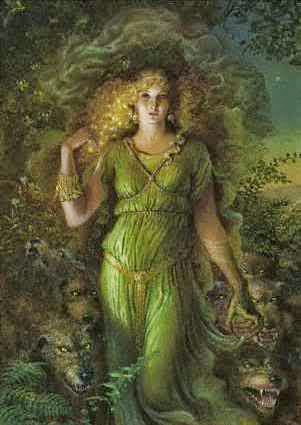Early Celtic Art
The relics of ancient Celtic art-work tell the same story. In the year 1846 a great pre-Roman necropolis was discovered at Hallstatt, near Salzburg, in Austria. It contains relics believed by Dr. Arthur Evans to date from about 750 to 400 B.C. These relics betoken in some cases a high standard of civilisation and considerable commerce. Amber from the Baltic is there, Phoenician glass, and gold-leaf of Oriental workmanship. Iron swords are found whose hilts and sheaths are richly decorated with gold, ivory, and amber.
]
The Celtic culture illustrated by the remains at Hallstatt developed later into what is called the La Tène culture. La Tène was a settlement at the north-eastern end of the Lake of Neuchâtel, and many objects of great interest have been found there since the site was first explored in 1858. These antiquities represent, according to Dr. Evans, the culminating period of Gaulish civilisation, and date from round about the third century B.C. The type of art here found must be judged in the light of an observation recently made by Mr. Romilly Allen in his “Celtic Art” (p. 13):
“The great difficulty in understanding the evolution of Celtic art lies in the fact that although the Celts never seem to have invented any new ideas, they possessed an extraordinary aptitude for picking up ideas from the different peoples with whom war or commerce brought them into contact. And once the Celt had borrowed an idea from his neighbours he was able to give it such a strong Celtic tinge that it soon became something so different from what it was originally as to be almost unrecognisable.”
Now what the Celt borrowed in the art-culture which on the Continent culminated in the La Tène relics were certain originally naturalistic motives for Greek ornaments, notably the palmette and the meander motives. But it was characteristic of the Celt that he avoided in his art all imitation of, or even approximation to, the natural forms of the plant and animal world. He reduced everything to pure decoration. What he enjoyed in decoration was the alternation of long sweeping curves and undulations with the concentrated energy of close-set spirals or bosses, and with these simple elements and with the suggestion of a few motives derived from Greek art he elaborated a most ]beautiful, subtle, and varied system of decoration, applied to weapons, ornaments, and to toilet and household appliances of all kinds, in gold, bronze, wood, and stone, and possibly, if we had the means of judging, to textile fabrics also. One beautiful feature in the decoration of metal-work seems to have entirely originated in Celtica. Enamelling was unknown to the classical nations till they learned from the Celts. So late as the third century A.D. it was still strange to the classical world, as we learn from the reference of Philostratus:
“They say that the barbarians who live in the ocean [Britons] pour these colours upon heated brass, and that they adhere, become hard as stone, and preserve the designs that are made upon them.”
Dr. J. Anderson writes in the “Proceedings of the Society of Antiquaries of Scotland”:
“The Gauls as well as the Britons—of the same Celtic stock—practised enamel-working before the Roman conquest. The enamel workshops of Bibracte, with their furnaces, crucibles, moulds, polishing-stones, and with the crude enamels in their various stages of preparation, have been recently excavated from the ruins of the city destroyed by Caesar and his legions. But the Bibracte enamels are the work of mere dabblers in the art, compared with the British examples. The home of the art was Britain, and the style of the pattern, as well as the association in which the objects decorated with it were found, demonstrated with certainty that it had reached its highest stage of indigenous development before it came in contact with the Roman culture.”17
The National Museum in Dublin contains many superb examples of Irish decorative art in gold, bronze, ]and enamels, and the “strong Celtic tinge” of which Mr. Romilly Allen speaks is as clearly observable there as in the relics of Hallstatt or La Tène.
Everything, then, speaks of a community of culture, an identity of race-character, existing over the vast territory known to the ancient world as “Celtica.”

